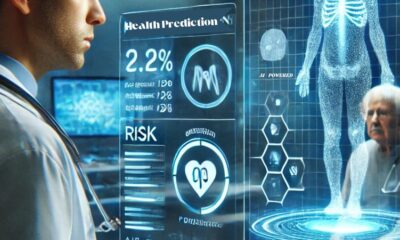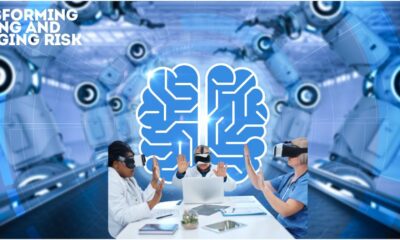Technology
How COVID-19 Changed Technology in the Workplace

COVID-19 has changed the way everything works. One of the areas significantly affected has been the workplace. Things have changed in how services and products are made and delivered to clients. People are working from home, consumers are forced to buy everything online, even more so than they were doing in the past, and almost all brick-and-mortar stores were forced to close their physical doors in an effort to keep people safe, at least at the beginning. Although many stores have been allowed to reopen their physical doors, the working world has been completely changed by COVID-19, and there is a good chance it will never go back to the way it used to be. Here are several ways COVID-19 has changed technology in the workplace.
Artificial Intelligence
As more people use technology in the office, artificial intelligence has made its way into working environments. With artificial intelligence making its way into the office, it is possible to have a workplace that runs off of both human brains and the power of robotics. Artificial intelligence has helped predict patterns in consumer’s buying behavior. Offices can look at what their consumers need and deliver. It is also possible to see the current market trends and react to them accordingly.
Autonomous Machines
Automated machines were in production for a very long time. Even though these machines have been in production for a while, it would have been a while before they got into the market. With the Covid protocol that requires reduced human interaction, these machines have come in handy. Drones deliver food and medicine to the sick, and 3D printers are used to print tools. All these machines were not in the market. With the pandemic, their production and utilization were necessary. Machines are now depended upon to carry out duties that people did before the pandemic.
5G Network and Satellite Constellation
With everyone being in the house and working from home, there was a need for a faster internet connection. Many jobs have gone online necessitating the need for better internet speeds. For this reason, 5G network was launched. It allows for easier and faster communication and data processing. Internet connection is now available to people who live in remote areas. The work has become one small digital village. Despite distance and disease separating many people, they can still meet online. Interaction is easier, and everyone stays safe.
More Online Platforms
Since many people are working online, more platforms are created to serve this purpose. The existing platforms before have also made adjustments to their software so more people can use them for communication. Working from home is easier for many people because of the platforms created, and anyone still in the office can be connected to those working from home with technology, creating a hybrid workplace. They are easily accessible and can be used to work and engage with staff from work. There are also platforms online for employees to get their schedule. Everyone knows what they need to do. These platforms may also monitor staff progress throughout the day. Everyone gets to stay productive even if they are not in the office and higher-ups are not having to worry about whether or not people are getting their work done despite being at home. The workday is able to go on as usual.
Sensors
As many people are stuck indoors, there have been more sensors installed around cities. Predictions show that these sensors will increase over the years to help monitor people. While it might seem like big brother is always watching, these sensors play a major role. In airports, they can be used to monitor the temperature of people moving into the airport. It makes it easier to spot and treat potential covid victims and helps with contact tracing as well.
Companies Can Be Paperless
An amazing revelation brought on by COVID-19 and the shift to working from home is that most companies can be completely or mostly paperless. The sudden change to online working forced many companies to figure out how to get business done over the internet, and quickly. With no office to go to, no paper copies to print, it became obvious that the use of paper copies was not necessary, thus helping the environment and saving trees. Businesses who would previously have scoffed at the idea of going completely to electronic documents were now forced to use these systems, or face the consequences. In this current world, companies that cling to the old ways are likely not to last, and would not survive in the case of another lockdown, if they somehow managed to survive the first at all. Data migration has actually helped a lot of companies become more efficient and many businesses plan to remain working remotely even after the pandemic is over.
Post-COVID Strategy
Even though the pandemic is still present, a time will come when the disease will be controlled. Many companies and leaders are looking at how the world will be post covid, and the role technology will play in such a setting. The pandemic saw many people lose their jobs, and people are trying to secure their current jobs. As life gets back to normal, these places need to see how they can incorporate their workers and technology together. Employers can still offer their workers employment and take advantage of the new technology in the market.
Covid 19 changed the way people look at life. The presence of technology has helped in the monitoring of the disease. Communication is easy, and people can still keep in touch despite the distance. There are still many things that people need to do to ensure they live in a digital world. However, there have been significant strides in technology, and more is still developing. Technology will soon affect every aspect of human lives, and it is something that needs everyone to be ready. The workplace has also remained open since people do not have to come to the office to work. Working from home has now become a new norm. Companies must either jump on the train of technology or expect to likely go out of business.
-

 Press Release6 days ago
Press Release6 days agoBellarium ($BEL) Price Prediction: Could It Hit $5 by 2026?
-

 Press Release3 days ago
Press Release3 days agoClinical Trials Market Set for Robust Growth, Driven by Drug Development Surge and Digital Innovation
-

 Business5 days ago
Business5 days agoHow Managed IT Solutions Help Small Teams Compete at Enterprise Scale
-

 Press Release4 days ago
Press Release4 days agoFill-Finish Pharmaceutical Contract Manufacturing Market Expected to Flourish Amid Biopharmaceutical Boom and Global Outsourcing Trend by 2035
-

 Press Release4 days ago
Press Release4 days agoIndustrial Boiler Market Expected to Surpass USD 24.4 Billion by 2035 Amid Growing Demand for Energy Efficiency and Industrialization
-

 Press Release4 days ago
Press Release4 days agoPreventive Vaccines Market to Witness Strong Growth by 2035
-

 Press Release4 days ago
Press Release4 days agoGreen Bio Chemicals Market Poised for Sustainable Growth amidst Global Shift to Eco-Friendly Alternatives by 2035
-

 Press Release4 days ago
Press Release4 days agoPet Food Nutraceutical Market Set for Robust Expansion Amid Rising Demand for Pet Wellness by 2035






























